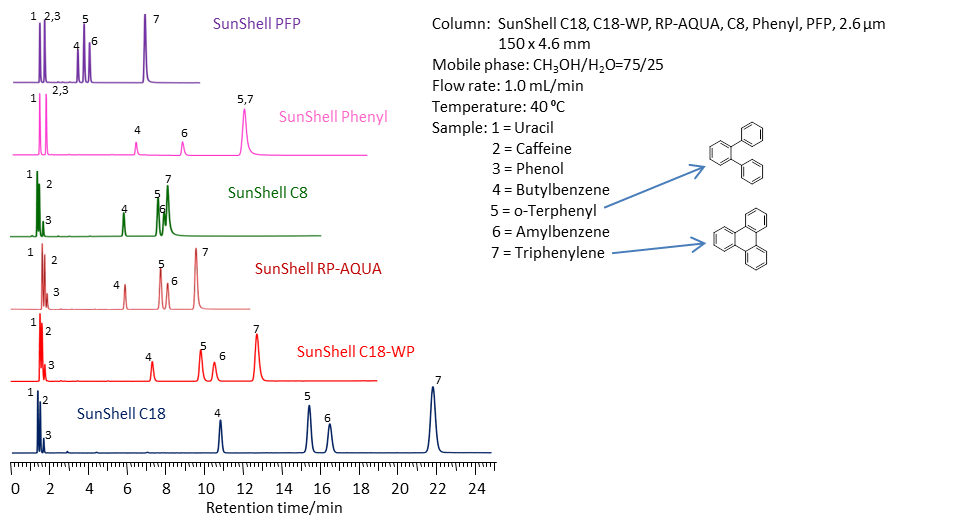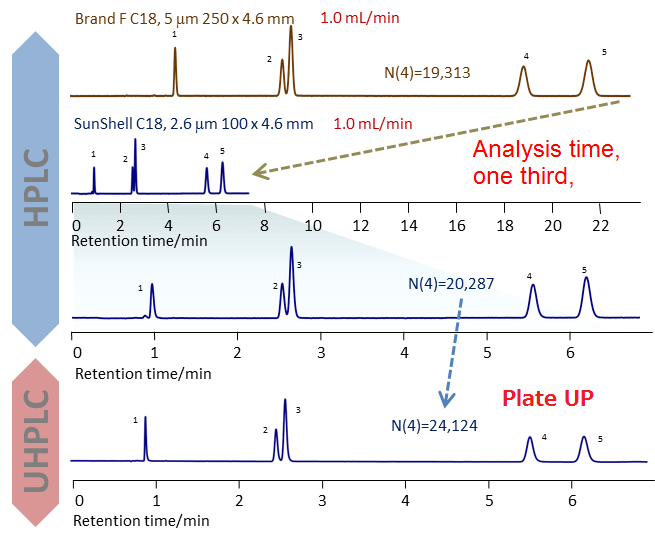Products
SunShell
Core-shell particle

SunShell column has not only an inert surface but also high stability due to deactivated silanol groups. SunShell 2.6 μm column can be used on both HPLC and UHPLC because it shows 2 times lower back presure than sub 2 μm column.
SunShell C18 2.6 μm sized 100x4.6mm has the same performance as a totally porous C18 5 μm sized 250x4.6mm, so that the same separation can be achieved by both columns without changing the separation condition consequently analysis time reduces one third.
Features of SunShell
Lineup
SunShell series are not only C18 column which is optional as the first choice column but also the other column of various separation properties. Hydrogen bond capacity, hydrophobicity, steric selectivity and feature are shown in the table.
| hydrogen bond capacity Caffeine / Phenol |
Hydrophobicity Amylbenzene / Butylbenzene |
Stereoselectivity Triphenylene / o-Terphenyl |
Feuture | |
|---|---|---|---|---|
| C18 | 0.39 | 1.6 | 1.46 | First Choice! |
| PFP | 1 | 1.31 | 2.38 | Halide, caion and structural isomers! |
| Phenyl | 1 | 1.48 | 1.01 | Aromatic compound! |
| C8 | 0.32 | 1.46 | 1.08 | High-speed analysis of non-polar compounds! |
| RP-AQUA | 0.52 | 1.52 | 1.3 | 100% aqueaus mobile phase is available! |
| C18-WP | 0.4 | 1.55 | 1.35 | Peptides and protains! |
The basic characteristics of the SunShell
| Particle size (µm) | Pore size (nm) | Specific surface area (m2/g) | Bonding | Carbon content (%) | End-capping | Use the highest pressure (MPa) | Use pH range | USP L No. | |
|---|---|---|---|---|---|---|---|---|---|
| C18 2.0 μm | 2.0 | 9 | 120 | C18 | 6.5 | Sunniest endcapping | 100 | 1.5 - 10 | L1 |
| C18 2.6 μm | 2.6 | 150 | 7 | 60 | |||||
| C18 5.0 μm | 4.6 | 90 | 5.5 | ||||||
| C18-WP | 2.6 | 16 | 150 | 5 | |||||
| RP-AQUA | C28 | 4 | 2 - 8 a) | L62 | |||||
| C8 | 9 | 150 | C8 | 4.5 | 1.5 - 9 | L7 | |||
| Phenyl | Phenylhexyl | 5 | L11 | ||||||
| PFP | Penta
fluorophenyl |
4.5 | TMS endcapping | 2 - 8 | L43 |
pH range when using a) an solvent 0% buffer only mobile phase
Comparison of theoretical plate and back pressure
Back pressure and theoretical plate were compared for 2 μm and sun 2 μm C18 and 2.6 μm SunShell C18. All columns showed almost the same theoretical plate except for brand A C18 1.9 μm.
However back pressure was not same. Especially Brand C C18 1.7 μm showed the highest back pressure. And SunShell C18 2.6 μm showed the lowest back pressure. On the comparison of theoretical plate per back pressure, SunShell indicated the largest value. This is a big advantage.
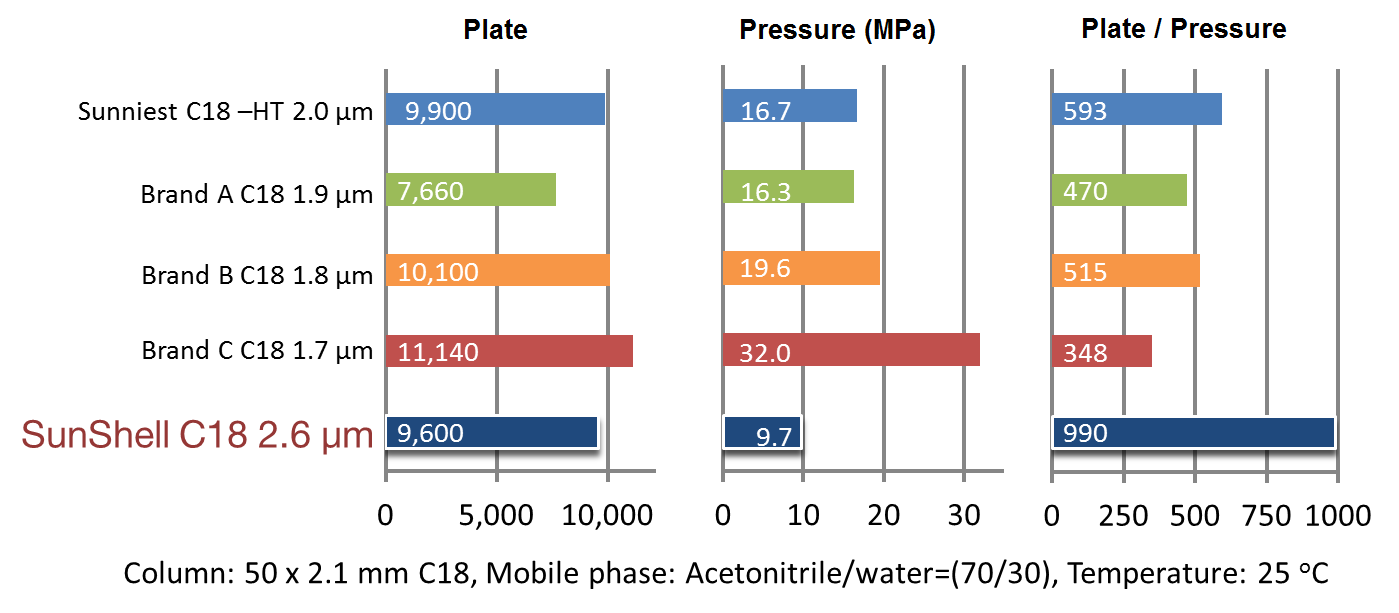
SunShell C18 2.6 μm 100 x 4.6 mm showed the same performance as conventional C18 5 μm 250 x 4.6 mm using HPLC.
An analysis time reduces to one third by only changing from conventional C18 column to SunShell C18 column and no changing the other conditions.
SunShell C18 showed 20% higher performance using UHPC than using HPLC.
To reduce total system volume of the HPLC using a semi-micro flow cell and 0.1 mm i.d. tubing, efficiency of SunShell C18 5 μm column improved to close true performance. Furthermore, decreasing the response speed and the short sampling time contribute high efficiency.

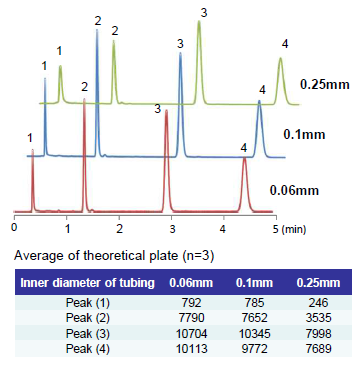
The relationship between the inner diameter of a tubing and theoretical plate was evaluated.
When the tubing with a large inner diameter was used, the dead volume in the tubing was large.
The larger the dead volume, the broader the peak. The tubing with 0.1 mm or less than 0.1 mm of inner diameter is recommended especially when 2.1 mm i.d. column is used.
5 μm core shell column sized 4.6 mm i.d. is acceptable for HPLC or semi-micro HPLC. However, UH`LC is recommended for a 2.1 mm i.d. column because of a low column volume.
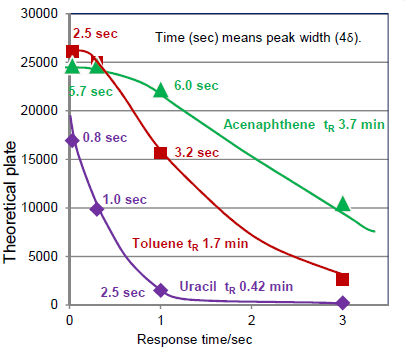
Response time of the detector is also important, when the peak width (4δ) is equal to or less than 1 second (above uracil) will need the following response time 0.03 seconds. Be about the peak width is 6 seconds, response time is desirable less than 0.3 seconds.
The same applies to further integrators of sampling rate, it is desirable to set the following 0.1 seconds.
Excellent end-capping
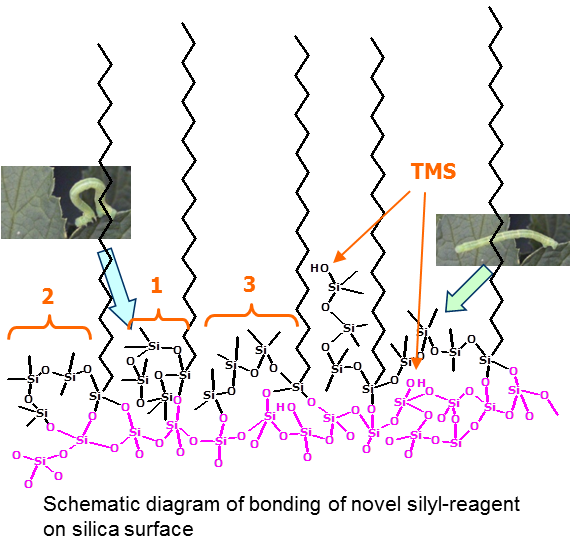
Hexamethyltri siloxane is used as an end-capping reagent. This reagent can stretch and be bent like a Geometrid caterpillar as shown in the figure, so that a functional group on the tip of the reagent can bond with a silanol group which is located anywhere.
This end-capping made influence of residual silanol groups the lowest. Then not only good peak shape of a basic compound but also excellent stability was achieved by this unique end-capping.
